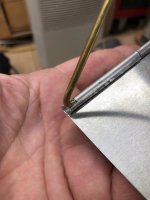Re-reading this build and going back to the original magazine article which is posted in another thread, I'm really impressed with the design of this oven and I'm a little surprised that with all the reflector ovens you can buy, including foldable ones, nobody is offering this design. I think is superior to what's currently on the market because of the simplicity of the folding, the compactness of it, the absence of any loose parts than can be lost, and, last but not least, the way the shelf is hinged so that it sits down slightly from the center line of the oven and gives a little head room for what you are baking. I see one of these in my future to replace my non-folding reflector oven that I built using Gil Gilpatrick's plans.
A couple comments/questions about your build:
Regarding the top, in addition to not using the clips shown in the plans, it looks like your top extends a bit further past the sides along its front edge compared to the photos of the as-built oven shown in the article in the magazine with the plans. Deliberate? Why?
As for the legs, I imagine one option to prevent the legs from collapsing is a piece of rod that stretches between the two legs? Attached it to one leg with an loop/eye and have it clip to the other leg with kind of a friction fit bend (sort of like the shape of a cotter pin) to go around the other leg?
If I were to make one, I might be tempted to substitute an appropriately-sized wire grate (I'd probably buy the grate and build the oven to size around it) in place of the aluminum shelf. When I built my reflector oven, Gilpatrick's plans called for a fixed, solid aluminum shelf. But I found that when I used a cookie sheet or pan on top of the shelf, the extra thickness of the solid shelf caused the bottoms of things to cook much too slowly compared to the tops. Eventually I cut out the shelf, except for 3/4" tabs at each side, so my cookie sheet/pan now rests on those tabs and is directly exposed to heat coming from the bottom. This cooks the bottoms of things more quickly but also more evenly with the top.
Thanks again for documenting your excellent build!!
A couple comments/questions about your build:
Regarding the top, in addition to not using the clips shown in the plans, it looks like your top extends a bit further past the sides along its front edge compared to the photos of the as-built oven shown in the article in the magazine with the plans. Deliberate? Why?
As for the legs, I imagine one option to prevent the legs from collapsing is a piece of rod that stretches between the two legs? Attached it to one leg with an loop/eye and have it clip to the other leg with kind of a friction fit bend (sort of like the shape of a cotter pin) to go around the other leg?
If I were to make one, I might be tempted to substitute an appropriately-sized wire grate (I'd probably buy the grate and build the oven to size around it) in place of the aluminum shelf. When I built my reflector oven, Gilpatrick's plans called for a fixed, solid aluminum shelf. But I found that when I used a cookie sheet or pan on top of the shelf, the extra thickness of the solid shelf caused the bottoms of things to cook much too slowly compared to the tops. Eventually I cut out the shelf, except for 3/4" tabs at each side, so my cookie sheet/pan now rests on those tabs and is directly exposed to heat coming from the bottom. This cooks the bottoms of things more quickly but also more evenly with the top.
Thanks again for documenting your excellent build!!
Last edited:

